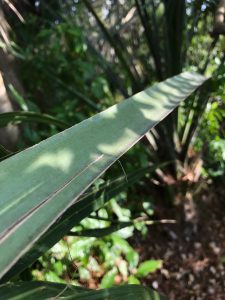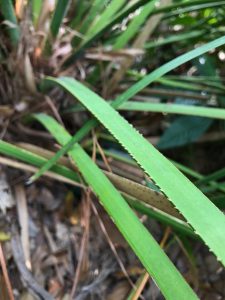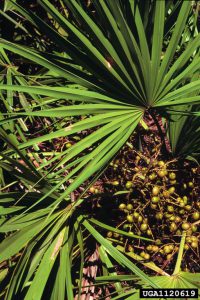The term “palmetto” gets thrown around a lot in the plant world. Sometimes “palmetto” is referring to the common name of the plant, or it could be the scientific name. There is a reason botanists aren’t a fan of common names and prefer to use Latin names, and that’s to ensure they are talking about the same plant no matter where they are in the world. Today we are going to look at cabbage palm (Sabal palmetto) and saw palmetto (Serenoa repens) and how to tell them apart.
First things first, let’s look at all the common names for “cabbage palm” to make sure we’re on the same page. This tree can also be referred to using part of its scientific name, “sabal palm”, but also as just plain “palmetto” or sometimes “swamp cabbage”. Cabbage palm also happens to be our state tree! You will often hear people say cabbage palm is not a “real” tree; rather, more closely related to grasses, but if I had to define what makes a tree a tree, cabbage palm would certainly fit the criteria 😉
Now, let’s explore how to tell cabbage palm from saw palmetto. If you’re looking at a tall (up to 65ft) tree, then that’s a cabbage palm. But, when cabbage palms are young, before sending up their trunk, they can look quite similar to saw palmetto. Here’s what to look for:
Frond
| Cabbage Palm | Saw Palmetto |
| The stalk that joins the leaf to the stem of the plant (petiole) runs through the middle of the leaf blade, giving the leaf a folded and droopy appearance. Also note visible fibers present. | Rounded outline, more erect appearance and generally smaller leaf, lacking fibers. |


Frond Stem or Petiole
| Cabbage Palm | Saw Palmetto |
| Long (6-7 ft), strong, stout, stiff and flattened above. Note again that the petiole runs through the middle of the leaf blade, coming to a point, and lacks “teeth”. | Shorter (1.5-3ft), more slender with curved prickles. Petiole stops abruptly and squarely at the leaf base. |


Fruit
Both species flower around the same time of year between May and July, but the fruit these fertilized flowers produce are quite different.
| Cabbage Palm | Saw Palmetto |
| Small (1/2 in long), rounded, lime green fruit that becomes shiny black at maturity. | Larger (1 inch), more egg-shaped, shiny golden-green fruit turning orange-yellow and eventually bluish-black when mature. |


Both of these plants are excellent sources of food and shelter for wildlife. Fruit from both species are consumed by white-tailed deer, songbirds, squirrels and wild turkeys. Cabbage palms serve as excellent nesting sites for the gray squirrel and if left unpruned, great habitat for our native bats too!
If you enjoyed this series and would like to read more about commonly confused plants and animals in Florida, you can find more here:
https://blogs.ifas.ufl.edu/global/tag/commonly-confused/
 1
1
